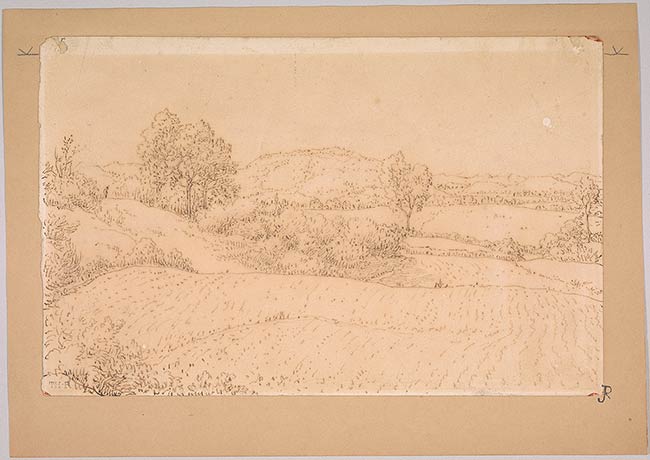

Among Rousseau's earliest drawings, found in a sketchbook now in the Minneapolis Institute of Arts (RF 82.104.1-.30), are a number of sketches made in 1825 during his first trip to the Jura, in the Franche-Comté region of northwestern France, when he was twelve years old. His talent led his cousin, the landscape painter Alexandre Pau de Saint-Martin (1782-1850), to encourage the young artist. After a trip to the forest of Compiègne with Pau, Rousseau entered the atelier of Guilllaume Guillon Lethière, before abandoning his academic training in favor of working directly from nature. In 1830 Rousseau began to travel France, an activity that shaped his career as a landscape painter. He made his professional debut at the Salon the following year.
In 1834, at the age of twenty-two, Rousseau returned to Franche-Comté. Along with his traveling companion Lorenz, the artist explored the mountains in Jura and Doubs, the western range of which forms the border with Switzerland. After traveling for about four months in the Jura, the two journeyed to the Swiss Alps. This trip preceded by two years Rousseau's first extended stay at Barbizon and his initial rejection by the Salon. His travels revived his work, and in 1835 he used sketches from his trip the previous year as the basis for Les Vaches dans le Jura (Mesdag Museum, The Hague, inv. RF hwm0286), which was one of the last paintings by the artist to be accepted to the Salon.
In 1862, five years before his death, Rousseau traveled through the Franche-Comté for the last time, visiting his wife's family and returning to Barbizon via the Col de la Faucille, the main pass of the Jura Mountains on the French-Swiss border, with a remarkable view of Mont Blanc and Lake Geneva. This study, dated by Michael Schulman to 1863, represents a view executed during these travels. The mountains of Doubs are to the northeast of the Jura and form a rugged backdrop to the wooded setting depicted here. The choice of pen and brown ink, in concert with the delicate technique composed of dots and short strokes of the pen, reflects Rousseau's interest in and study of Dutch seventeenth-century drawing. Here he made the initial sketch in graphite, probably en plein air, and then more carefully executed the final drawing in pen and ink, perhaps in his studio. This sheet was purchased from the artist's estate by Alfred Sensier, a lifelong friend of the artist and the author of an 1872 monograph, Souvenirs sur Th. Rousseau.
Estate stamp at lower left, "TH.R." (Lugt 2436).
Watermark: none.
Sensier, Alfred, 1815-1877, former owner.
Joseph-Rignault, Emile, former owner.
Aubry, Georges, former owner.
Rewald, John, 1912-1994, former owner.
Rewald, John, Mrs., former owner.
Thaw, Eugene Victor, former owner.
Thaw, Clare, former owner.
Thaw Catalogue Raisonné, 2017, no. 343, repr.
The Thaw Collection : Master Drawings and Oil Sketches : Acquisitions since 1994. New York : Pierpont Morgan Library, 2002, no. 38.
